A ripple of laughter rolled through the audience, a second or two before Judith began ‘Brabyns Hall and Iron Bridge’. The tittering was a result of Judith being introduced, not once but twice, in a trice. Does this mean our chairman Hilary is ‘losing it’? Why so? You won’t find the answer here; you will have to seek out one or more of the 85 who ventured to the Methodist church on a chilly, dark evening in January, for an explanation.
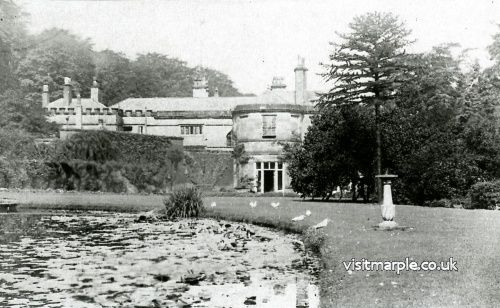
Judith’s talk swept us through the history of Brabyns Estate, and the Iron Bridge, passing on the way St. Martin's Church and Poynton. An evening’s exploration of the families involved, and their involvement and contribution to local society. The story starts in the 18th century weaving through time to the present day, and even into the future – of the 1813 Iron Bridge.
Dr Henry Brabin, a Stockport surgeon, built a Georgian house on the land, facing down the valley away from the main road, with the entrance to the drive past the lodge on Brabyns Brow. His wife Elizabeth Lowe, had inherited the 40 acres of the estate, upon her father’s, John Lowe, death. Henry died in 1750, Elizabeth outliving her husband by forty years, never remarrying.
Their only surviving child Elizabeth, widowed after six months of marriage to Nathaniel Bradshaw Isherwood of Marple Hall in 1765, married Edward Whitehead, in 1776 the couple deciding to live in Soho, London. From 1783 the estate was leased, by Elizabeth Brabin, five years later Elizabeth died. The estate was then sold to Nathaniel Wright, a wealthy mine and land owner. The Society learned something of his activities as a result of David Kitchin’s talk on 21st February 2022.
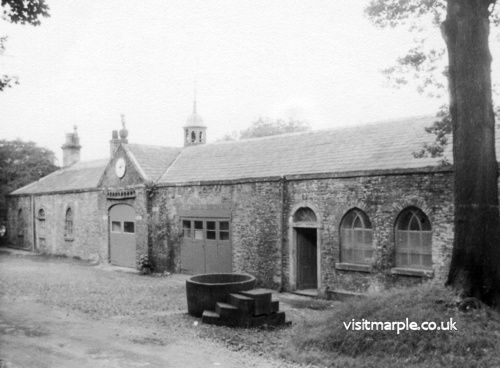 Brabyns Hall Stables, demolished in the 1970s.We now enter the era, when the ownership of the estate followed the maxim ‘keep it in the family’ for some 140 years.
Brabyns Hall Stables, demolished in the 1970s.We now enter the era, when the ownership of the estate followed the maxim ‘keep it in the family’ for some 140 years.
Nathaniel proceeded to make improvements to the estate, including extensions, new buildings and building the Iron Bridge, over the Goyt, in 1813. In 1779 the world’s first cast iron bridge was erected at Coalbrookdale. Though more modest, Marple’s iron bridge is a unique structure of national importance, Grade II listed, one of the few cast iron bridges surviving from that period. This bridge across the Goyt created a carriage way from Compstall.
However, not only carriages have crossed this bridge as we discovered in this website article of 2021 A Jaunt in the Country.
More of this structure will be revealed later.
Wright also had ambitions to use his estate as a base for manufacturing. With the Goyt flowing through the estate, it would seem to provide a ready-made power source. In 1804 he built a weir across the Goyt, together with a sluice and reservoirs, in order to power a factory. A factory that was never built. This is now known, locally, as 'Wright's Folly'. But is it so? The answer lies within Brabyns Hall & Park by Ann Hearle, available in either digital or paper form.
After Nathaniel’s death in 1818, his son John came into his inheritance at 18, There was considerable manoeuvring of property and John Wright eventually sold on his father's coal mining interests when he was in his mid-twenties Immersing himself in local affairs, he became a JP and one of the five Stockport Magistrates. Further land around the estate, was bought, the purchase financed by sale of part of his inheritance of business interests and land elsewhere.
We now come to the reign over the estate of three formidable Hudson women, Ann, Maria Anne and Fanny Marian which will lead us through to 1941 and a car park.
Ann Hudson gained the estate, after the death of her cousin John Wright, who never married. Ann moved into the hall, following the death of her husband, in 1868. Ann had the company of daughter Maria Anne and her recently orphaned, granddaughter, Fanny Marian.
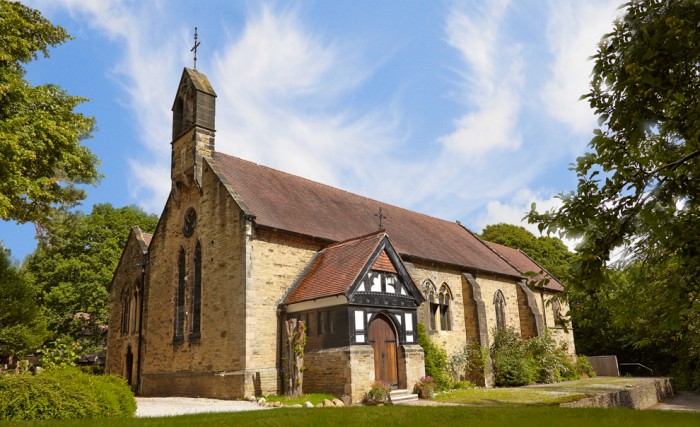
As did John Wright so do the Hudson's, involving themselves with local affairs. At this point Judith took us on a slight detour, scaling part of the North Face of Brabyns Brow to Marple’s 'hidden gem’ - St Martin’s Church. The Hudsons, paid for the building of St. Martin's Church. They were influenced by the Oxford Movement and the revival of ritual in the Church of England.
Maria Anne inherited the estate in 1884, upon the death of her mother, Ann. When Maria Anne died in January 1906, her unmarried niece Fanny Marian Hudson inherited the estate, then valued at £56,038 3s 11d (in 2022 the equivalent of £5 million.) Thomas Dolling Bolton MP (b1841) who had represented Derbyshire North East, a mining constituency and campaigned for a maximum eight hour day, was Fanny Marian's cousin. On his death in 1906 Fanny Marian was a benefactor of his will, to the tune of £57,000 (2022 £5.25 million Bank of England calculator)
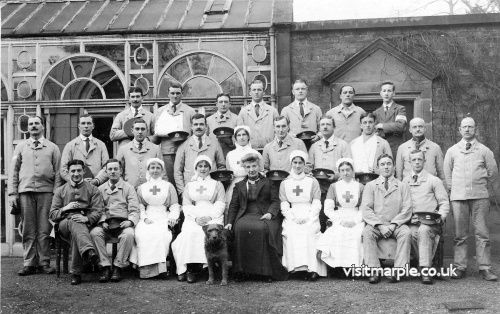 Brabyns Hall WW I: Casualties (hats off) and medical staff with Miss Fanny Marian Hudson (centre) and dog JackDuring World War I the Hall acted as an Auxiliary Hospital and Convalescent Home, Fanny Marian Hudson, then in her early sixties, acted as Matron. She had a wooden hall constructed in Marple Bridge, on Lower Fold, to enable soldiers to have recreational activities. The hospital hosted the Duchess of Westminster in March 1916. After the closure of the hospital Fanny Marian continued to live there for another twenty two years until her death in 1941, but as she became increasingly older the estate fell into a gentle decline with less maintenance.
Brabyns Hall WW I: Casualties (hats off) and medical staff with Miss Fanny Marian Hudson (centre) and dog JackDuring World War I the Hall acted as an Auxiliary Hospital and Convalescent Home, Fanny Marian Hudson, then in her early sixties, acted as Matron. She had a wooden hall constructed in Marple Bridge, on Lower Fold, to enable soldiers to have recreational activities. The hospital hosted the Duchess of Westminster in March 1916. After the closure of the hospital Fanny Marian continued to live there for another twenty two years until her death in 1941, but as she became increasingly older the estate fell into a gentle decline with less maintenance.
In her will Fanny Marian left instructions that Marple, Romiley and Bredbury councils were to be given the first chance to buy the hall for a nominal sum. With the help of Cheshire County Council the estate was purchased, opening as a public park in 1949. This period of the estate was not without controversy, for in late 1944 the council felled over 500 trees on the estate, some of which were healthy. However, the plans to create a community building and memorial out of the Hall were not as successful and the Hall was demolished around 1953 after years of neglect.
And the car park? As we all know, the Brabyns Park car park is the site of Brabyns Hall.
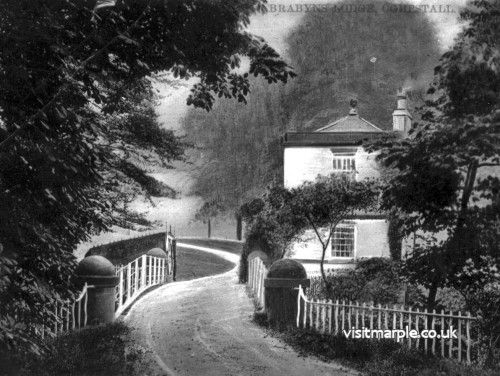
How elegantly the Iron Bridge once blended into its surroundings!
Judith then took us along to the annex of her talk, Nathaniel Wright’s Iron Bridge downstream of his so called ‘folly’ weir. The Iron Bridge was installed in 1813 the date is embossed on the structure. Nearby is a stone bridge spanning a small stream and with Nathaniel Wright's initials and the date 1804 on the keystone. The Iron Bridge, built by Salford Ironworks, provided a private entrance from Compstall, a short cut when approaching the house from the north. The bridge was left to its own devices, enduring years of neglect until a structural assessment in 1991. The resultant report can be summarised as seeing the bridge to be in a ‘dangerous condition’, a Bailey Bridge was installed as a temporary measure. The problems with the bridge led to a prolonged effort to raise funds to restore the bridge. It was finally in restored 2008 by Dew Engineering, project managed by Stockport MBC, funding raised by the local community with much assistance from Heritage Lottery Fund. History enthusiasts Mark Whittaker and Peter Clarke had begun campaigning for the restoration of the Iron Bridge in Brabyns Park in June 2001, remaining the driving force throughout the project.
This CGI film was created back in 2007/8 by Take 27 Ltd as part of the Brabyns Park Iron Bridge Restoration Project.
Unfortunately the restoration project wasn't the end of the story, as the council failed to carry out maintenance recommended in inspection reports following the bridge's restoration of 2008. After much pushing by the President of the Society, Mark Whittaker, a Principal Inspection was carried out in September 2021. The report made grim reading, the inspection revealing that there are "two high importance structural members in a critical condition" with cracks. These are "significant defects which", according to the report, "need repairing to avoid potential failure of the original structure".
Read more, much more at https://www.marple.website/brabyns-park-iron-bridge/iron-bridge-project.html
The story continues.
We must thank Judith for an enjoyable evening of revealing the story behind a well-known local spot.
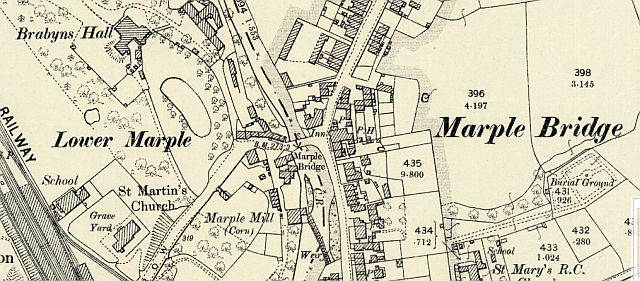 From the OS 25 inch map of 1896, click the image to see the Iron Bridge area
From the OS 25 inch map of 1896, click the image to see the Iron Bridge area
for the full map click - National Library of Scotland collection of OS Maps

